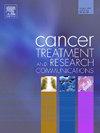转移性尿路上皮癌铂基化疗后的派姆单抗:来自荷兰全国队列和KEYNOTE-045患者的比较
IF 2.4
Q3 Medicine
引用次数: 0
摘要
背景和目的:在一线采用enfortumab-vedotin联合派姆单抗之前,铂基化疗仍然是转移性或局部晚期尿路上皮癌(mUC)患者的标准治疗方案。基于KEYNOTE-045试验,二线派姆单抗可能提供给疾病进展的患者。目前尚不清楚KEYNOTE-045的研究结果在常规临床实践中对荷兰mUC患者群体的转化效果如何。本研究的目的是比较全国人群为基础的派姆单抗治疗队列患者的特征和结果与KEYNOTE-045试验。方法从荷兰全国癌症登记处和前瞻性膀胱癌基础设施中确定了一个当代队列,包括2018年1月至2023年6月期间诊断为膀胱同步mUC的所有患者,接受铂基化疗和随后的派姆单抗治疗,并与KEYNOTE-045派姆单抗(knp)组进行比较。主要发现:荷兰队列包括249例患者;整个KN-P组包括270例患者(没有重叠患者)。荷兰队列包括更多ECOG≥2 (10.3% vs 1.1%)、血红蛋白水平≥10g/dL (29.8% vs 16.4%)和基于卡铂的化疗(49.0% vs 25.9%)的患者。荷兰队列中至少有24.5%的患者不符合KEYNOTE-045的条件。荷兰队列的中位派姆单抗持续时间和总生存期分别为2.5个月(0.1-35.6)和5.5个月(95%CI: 4.4-7.3),而KN-P组的中位派姆单抗持续时间为3.5个月(0.1-20.0)和10.1个月(95%CI: 8.0-12.3)。结论:与KN-P组相比,这一全国性队列在患者、疾病和治疗特征方面存在相当大的差异,预后特征普遍较差,生存率较差。对异时性mUC或上尿路mUC患者的敏感性分析没有改变结果。这些发现强调了根据KEYNOTE-045标准进行充分患者选择的重要性,同时也说明了常规临床实践和临床试验中患者群体之间的差异。本文章由计算机程序翻译,如有差异,请以英文原文为准。
Pembrolizumab after platinum-based chemotherapy for metastatic urothelial cancer: comparison between patients from a Dutch nationwide cohort and KEYNOTE-045
Background and objective
Pending adoption of enfortumab-vedotin plus pembrolizumab in first-line setting, platinum-based chemotherapy remains the standard of care for patients with metastatic or locally advanced urothelial cancer (mUC). Second-line pembrolizumab may be offered to patients with disease progression, based on the KEYNOTE-045 trial. It is unclear how well the findings from KEYNOTE-045 translate to the Dutch mUC patient population in routine clinical practice. The objective of this study was to compare characteristics and outcomes of patients in a nationwide population-based pembrolizumab-treated cohort with the KEYNOTE-045 trial.
Methods
A contemporary cohort including all patients diagnosed with synchronous mUC of the bladder from January 2018 - June 2023, treated with platinum-based chemotherapy and subsequent pembrolizumab, was identified from the nationwide Netherlands Cancer Registry and Prospective Bladder Cancer Infrastructure, and compared to the KEYNOTE-045 pembrolizumab (KN-P) arm.
Key findings
The Dutch cohort included 249 patients; the full KN-P arm included 270 patients (no overlapping patients). The Dutch cohort comprised more patients with ECOG≥2 (10.3% vs 1.1%), hemoglobin levels <10g/dL (29.8% vs 16.4%), and carboplatin-based chemotherapy (49.0% vs 25.9%). At least 24.5% of patients in the Dutch cohort were KEYNOTE-045 ineligible. Median pembrolizumab duration and overall survival were 2.5 (range <0.1-35.6) and 5.5 months (95%CI: 4.4-7.3) in the Dutch cohort, versus 3.5 (<0.1-20.0) and 10.1 months (95%CI: 8.0-12.3) in the KN-P arm.
Conclusion
This nationwide cohort demonstrated considerable differences in patient, disease and treatment characteristics as compared to patients in the KN-P arm, with generally less favorable prognostic characteristics and worse survival. Sensitivity analyses on patients with metachronous mUC or mUC of the upper urinary tract did not alter the findings. These findings highlight the importance of adequate patient selection according to the KEYNOTE-045 criteria while also accounting for disparities between patient populations in routine clinical practice and those in clinical trials.
求助全文
通过发布文献求助,成功后即可免费获取论文全文。
去求助
来源期刊

Cancer treatment and research communications
Medicine-Oncology
CiteScore
4.30
自引率
0.00%
发文量
148
审稿时长
56 days
期刊介绍:
Cancer Treatment and Research Communications is an international peer-reviewed publication dedicated to providing comprehensive basic, translational, and clinical oncology research. The journal is devoted to articles on detection, diagnosis, prevention, policy, and treatment of cancer and provides a global forum for the nurturing and development of future generations of oncology scientists. Cancer Treatment and Research Communications publishes comprehensive reviews and original studies describing various aspects of basic through clinical research of all tumor types. The journal also accepts clinical studies in oncology, with an emphasis on prospective early phase clinical trials. Specific areas of interest include basic, translational, and clinical research and mechanistic approaches; cancer biology; molecular carcinogenesis; genetics and genomics; stem cell and developmental biology; immunology; molecular and cellular oncology; systems biology; drug sensitivity and resistance; gene and antisense therapy; pathology, markers, and prognostic indicators; chemoprevention strategies; multimodality therapy; cancer policy; and integration of various approaches. Our mission is to be the premier source of relevant information through promoting excellence in research and facilitating the timely translation of that science to health care and clinical practice.
 求助内容:
求助内容: 应助结果提醒方式:
应助结果提醒方式:


